Lava Xolo X900 Review - The First Intel Medfield Phone
by Brian Klug on April 25, 2012 6:00 AM ESTBattery Life
Nailing performance is one thing, but in order to really sell Medfield and other upcoming SoCs to OEMs, Intel has to deliver battery life and power consumption that's competitive. It's about performance/power in the SoC space. First, it's worthwhile to note that the X900 includes a relatively small battery, at just 5.4 Whr. Of late, batteries over 6 Whr seems like the norm, and I'm told that future designs including the Motorola phone will probably include larger ones. It's just good to have that frame of reference and this chart should help:
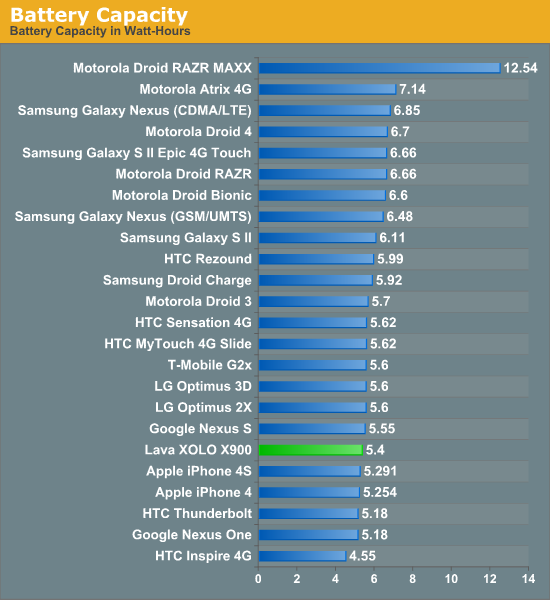
Intel notes battery life in their own X900 announcement blast as being around 5 hours of continuous 3G browsing and 8 hours of talk time. Our own numbers end up being pretty darn close, at 4.6 hours and 8.5 hours for those two metrics, respectively.
As a reminder, the browsing tests happen at 200 nits and consist of a few dozen pages loaded endlessly over WCDMA or WiFi (depending on the test) until the phone powers off. The WiFi hotspot tethering test consists of a single attached client streaming 128 kbps MP3 audio and loading four tabs of the page loading test through the handset over WCDMA with the display off.
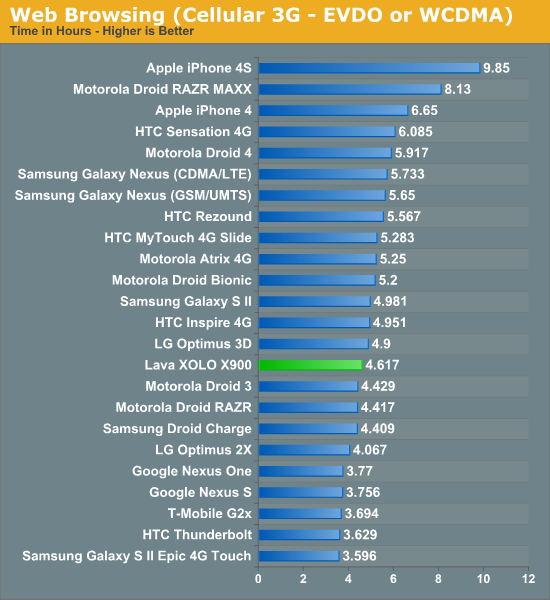
As a smartphone the X900 does a bit below average here, but as we mentioned it also has an unusually small battery for a modern flagship Android smartphone. If we divide battery life by battery capacity, we can get a better idea for how the Medfield platform compares to the competition:
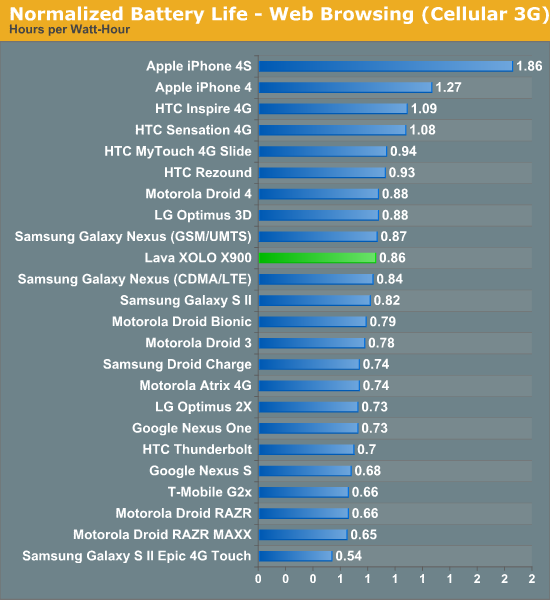
Normalizing for battery capacity, the X900 actually does a bit above average. In other words, the Medfield platform appears to be just as power efficient as some of the newer OMAP 4 based smartphones.
On WiFi the situation is no different:
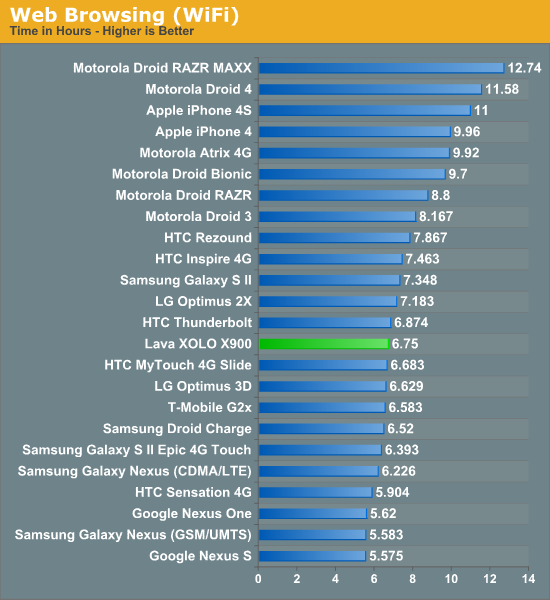
Again we see reasonable numbers for the X900 but nothing stellar. The good news is that the whole x86 can't be power efficient argument appears to be completely debunked with the release of a single device. To move up in the charts however, Intel needs to outfit its reference design with a bigger battery - something I've heard is coming with the Z2580's FFRD. The normalized results put the X900 at the middle of the pack:
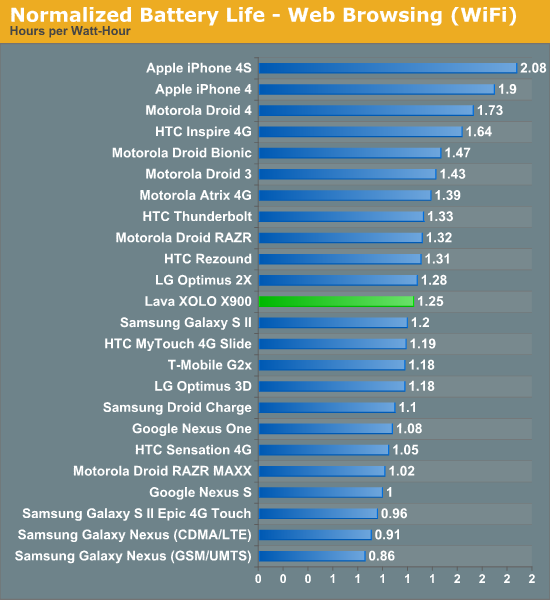
We see similar results in our talk time and 3G hotspot tests:

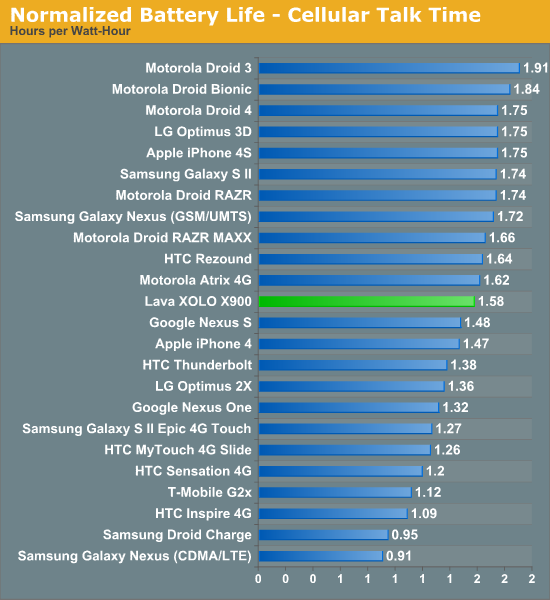
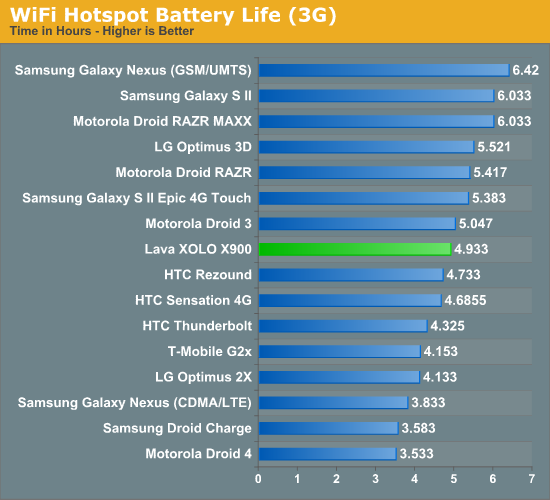
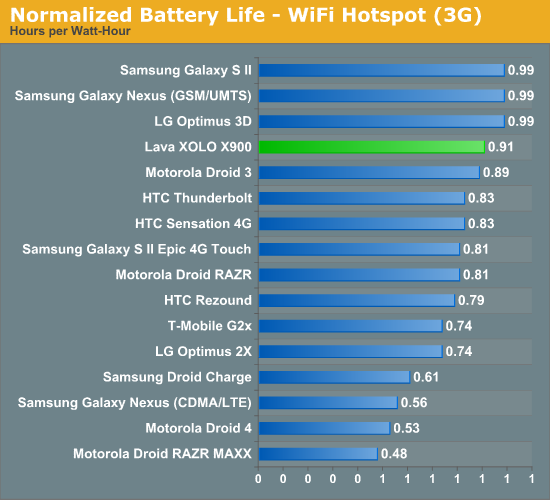










106 Comments
View All Comments
tipoo - Wednesday, April 25, 2012 - link
Looks like Krait still has a significant lead over Intels competitor, and it was shipping sooner. Intels doesn't have better CPU performance, GPU performance, or battery life, it's just ok at everything. I think their advantage will no doubt grow with 22nm, but for now we finally see Intel entering some stiff CPU competition, even if its for the low power draw segment.Lucian Armasu - Wednesday, April 25, 2012 - link
That's the question: why would manufacturers care? Just because it's Intel? And why would they want to repeat the PC situation where they got an Intel lock-in, when there's much better competition with ARM makers, and they can get the chips for a much cheaper price (which Brian didn't take into account in this review).haar - Wednesday, April 25, 2012 - link
<strong> But, can it play Crysis? </strong>. ROFLMAO! (sorry, first and last time i will use this... but really it is a perfect line imao)y2kBug - Wednesday, April 25, 2012 - link
It seems that Intel put a lot efforts to make Android run on x86. Even if I think that this will not bring Intel any money in return; here is an idea how to make these efforts not to die in vain. Make this runtime work on Windows, so that we can run Android apps on the upcoming Windows 8 tablets. This will make upcoming Windows 8 tablets so much more useful from the very start.superPC - Wednesday, April 25, 2012 - link
YouWave ( http://youwave.com/ ) and BlueStack ( http://bluestacks.com/ ) can already do that on windows 7 right now. BlueStack has shown that it can run android apps on windows 8 PC (it just doesn't have live tiles http://www.youtube.com/watch?v=SKAOkpX7Q2E ).aegisofrime - Wednesday, April 25, 2012 - link
Am I the only one who can't wait for an Android phone rocking ULV Haswell? That is gonna be such a beast. Modern in-order architecture + hopefully decent GPU.tipoo - Wednesday, April 25, 2012 - link
Yeah, Atom is quite an old architecture now in chip terms, a redesign could bring Intel back up in a huge way. While I was disappointed by this SoC, bearing in mind how old it is and its competing against new designs like Krait, I guess they could do much much better with a real new Atom.Khato - Wednesday, April 25, 2012 - link
Whereas my guess is that we'll be seeing conroe-class performance out of the silvermont cores in Medfield's successor. Hence why I couldn't help but chuckle at the second to last line in the review, "What I'm waiting for is that Conroe moment, but in a smartphone."tipoo - Wednesday, April 25, 2012 - link
Conroe class performance would certainly bring these devices up to "good enough" territory. But current Atoms are only a fraction that performance still. We'll have to wait and see I guess.B3an - Thursday, April 26, 2012 - link
You're both idiots if you think Intel could get Conroe class or vastly better Atom performance out of 32 or 22nm.The whole reason Intel have used the 'old' Atom design in the first place is because it's simple and small, which means lower transistor count, smaller die, and lower power consumptions. If you honestly think they could have got Conroe level complexity or performance in a phone SoC with anywhere near acceptable power consumption and die size, even at 22nm, then you're both living in a fantasy universe.